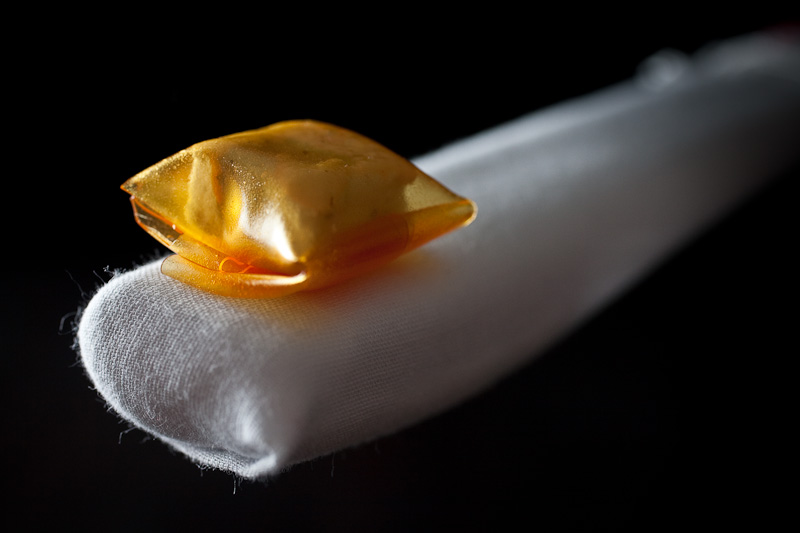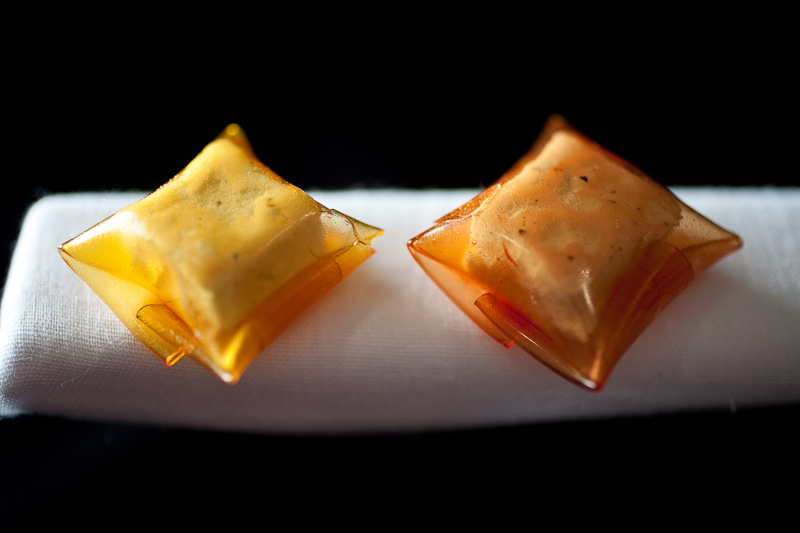
So I think I’ve come to a conclusion: as a cookbook, the Alinea cookbook is less than ideal in a few ways. It’s vague in the way that stopping at a gas station to ask directions to the freeway and being told by the attendant to “head a few blocks that way” when the actual directions are “head three blocks over, but be aware that the road is under construction at that point and you’ll need to take a detour south, but don’t get on Sutter or you’ll be forced in the wrong direction and can’t turn around for 8 more blocks, and don’t try to get on Taranaki or you’ll be merged onto the freeway going in the wrong direction and there isn’t an exit for 5 miles” is vague.
The recipes are poetically brief, and all have a very matter-of-fact tone that imply that following them simply will yield perfect results. There is very little “do this step quickly” or “you might find it helpful to” or “if it starts smoking you’ve fucked it up”. The problem is, I haven’t yet been able to make a single one of these recipes perfectly right out of the gate (with the exception of the Lettuce one). I’ve so far been contenting myself to just make it a learning experience, but I reached the breaking point on this one.
The recipe for this one, as printed in the book, is just wrong. Chef Achatz corrects this in the Alinea Mosaic, but I didn’t think to look this up until after I ended up with pineapple slop all over my countertop the first time and tried to consult the Mosaic to figure out what I’d done wrong. Future editions will have this corrected; this is the price I pay for being an early adopter, I guess.
The second time around, the pineapple mixture set a bit better, but was impossible to get off the sheets of acetate I was instructed to pour it on. Also, the book gives no indication of how big a sheet of acetate I need (Answer: for one batch, I found two 16×20″ sheets to be acceptable. You can do it one one large sheet but my countertops are small). There’s no description of what you should be looking for when the drying process of the pineapple glass is complete other than the ability to pull it off the acetate in one big sheet, which mine definitely was not capable of.
So I did it a third time. This time, I sprayed the acetate with cooking oil and wiped it off. I found that leaving the mixture to cool after blending it caused it to thicken, which helps make it much more manageable when spreading it on the acetate. Also, a tip for anyone who cares: a creme brulee torch, when whisked quickly over a gel-like substance, will draw bubbles up and out of it. I learned this from my dad, who works at a hardware store.
This third time worked.
But enough bitterness for now. I had originally wanted to talk a bit in this post about the wonder that is Tapioca Maltodextrin, my favorite new ingredient. It’s fascinating. As it turns out, though I found out something even MORE fascinating while making the bacon powder for this dish. The recipe directs me to fry 12 slices (170 grams) of bacon. From this, I am supposed to have at least 100g of fat. I didn’t really notice the relationship between these two numbers until I started frying my New Zealand bacon. NZ bacon has always tasted different to me in a way I haven’t been able to articulate other than “not as good as the bacon my dad made on sunday mornings when I was growing up”.
So I fried up a pack of NZ bacon. This pack weighed in at 300g…nearly twice what the recipe called for. When I had reduced it to teensy shards of cooked bacon bits, I poured off the fat. 19g.
Dang.
In the end, I had to fry three entire packs of bacon, weighing in at 730g, to produce a scant 100g of bacon fat. NZ pigs, apparently, are 430% healthier than American pigs.
The bacon powder, once mixed, was extremely delicate. I was instructed to form the powder into cubes with my fingers, but this was tedious and tough to do. The powder had a strange insistence to stick to my fingers more easily than itself.
All told, it had taken me the better part of this week to get these ingredients all together and working. In addition to the pineapple glass, I took a shot at making Pink Grapefruit glass. The proportions of this recipe (as with all of them so far) have been grossly out of synch. The glass yields the advertised 8 servings, but the bacon powder could easily be used to make 100 or more of these things.
So. After all the frustration, how was it?
Hands down my favorite thing I’ve made yet. These things are utterly astounding. The final dehydration step turns them from a gummy, difficult mess into an extremely delicate flavorful bite. The glass shatters easily as you crunch it, and the pineapple is aggressively flavorful. The bacon powder melts into a warm deliciousness on your tongue, coating your mouth with the feel of the bacon fat and tasting amazing. My grapefruit juice ones were also good, though the citrus is more delicate and the glass sticks to my teeth more. I’m quite happy to have tried this variation though.
Of the things I’ve made so far, this one would be the on I’d most likely make again and again.

awesome, what type of blender did you use? I have tried this several times and my “mixture” never works out
I don’t think it’s anything terribly special…it’s the blender that came with my Kenwood food processor (of which I’m extremely fond, but I don’t know that they’re sold in the States). I think it’s more the patience of blending for 10 minutes; the first time I made this I blended for MAYBE a minute before I figured “eh, good enough”.